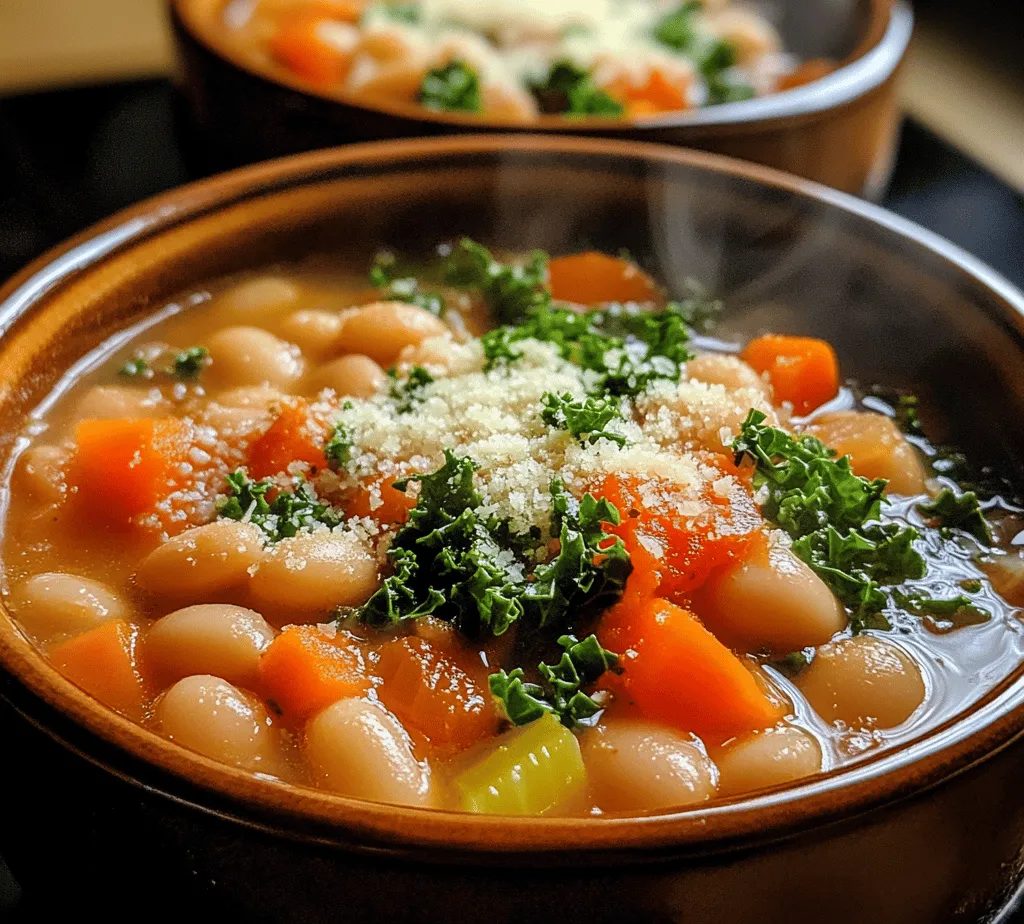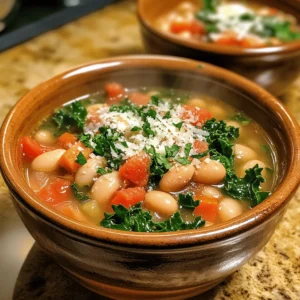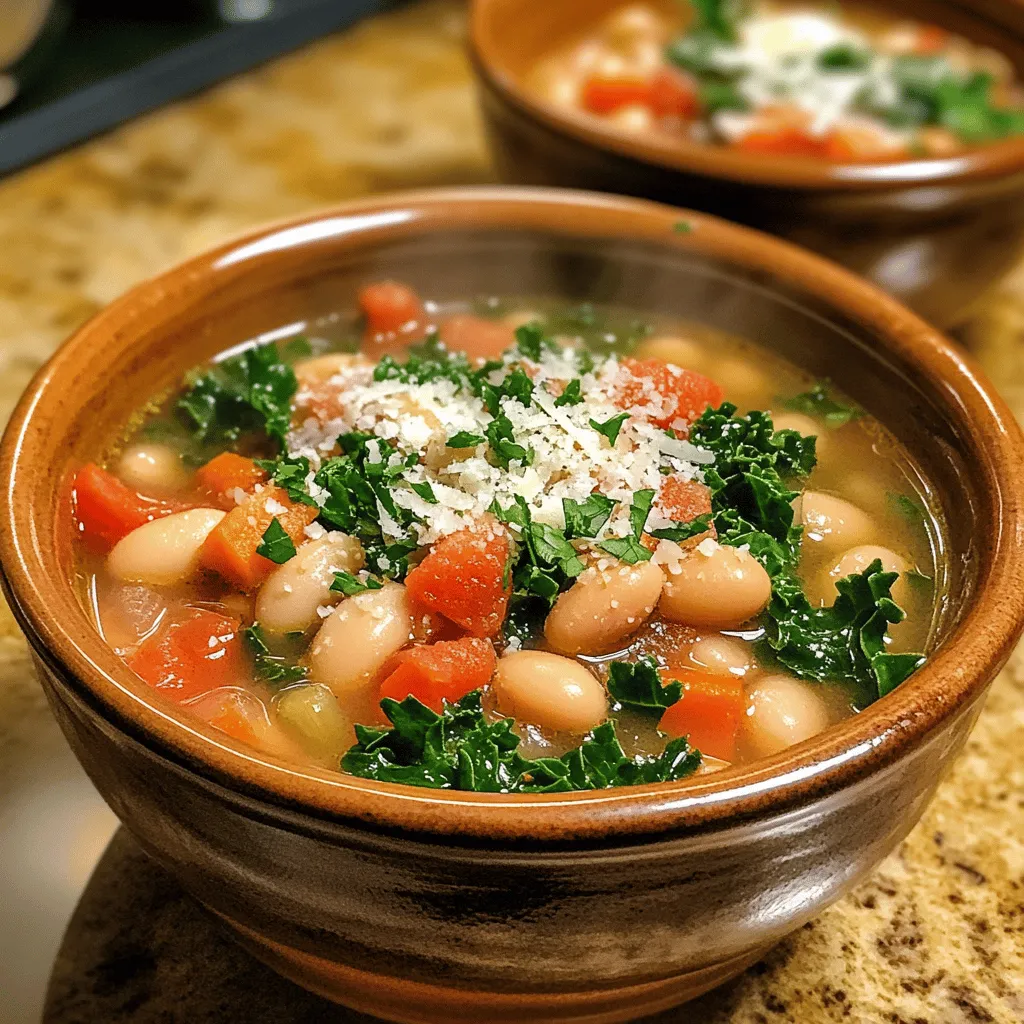Introduction
When you think of Tuscan cuisine, the first thoughts that often come to mind are rustic flavors, wholesome ingredients, and a deep connection to the land. The Tuscan region of Italy is known for its simplicity and emphasis on fresh, locally-sourced produce. This culinary tradition celebrates the Mediterranean’s bounty, showcasing vibrant vegetables, hearty grains, and savory herbs. One dish that perfectly encapsulates these qualities is Tuscan White Bean Soup.
This nourishing and hearty soup is not just a meal; it’s a warm embrace in a bowl that brings together the rich heritage of Tuscan cooking and the health-conscious approach many are seeking today. The star ingredient, cannellini beans, packs a protein punch while contributing a creamy texture that makes the soup both satisfying and nourishing. Coupled with fresh greens like kale or spinach and a medley of vegetables, Tuscan White Bean Soup is a delightful way to incorporate a variety of nutrients into your diet.
The versatility of this recipe is yet another reason it has gained popularity among home cooks and food enthusiasts alike. Whether you follow a vegetarian lifestyle, are looking for a gluten-free meal option, or simply want to enjoy a hearty soup, Tuscan White Bean Soup can easily adapt to meet those needs. Plus, with the option to enhance it with flavorful ingredients like Parmesan cheese, every bowl can be customized to your liking.
The Ingredients: A Closer Look
Key Ingredients Overview
To create a truly memorable Tuscan White Bean Soup, it is important to use high-quality ingredients that not only enhance the flavor but also provide a wealth of nutritional benefits. Here’s a closer look at the essential components of this comforting dish.
Cannellini Beans: Dried vs. Canned
At the heart of this recipe are cannellini beans, known for their creamy texture and nutty flavor. You have the option to use either dried or canned beans in your soup. Dried cannellini beans require a bit of preparation but offer a fresher taste and firmer texture. When using dried beans, it’s essential to soak them prior to cooking, which helps to reduce cooking time and improve digestibility. The soaking process also allows the beans to rehydrate, making them plump and tender when cooked.
Conversely, canned cannellini beans are convenient and can be a time-saver, especially on busy weeknights. They are already cooked, making them a quick addition to your soup. In terms of nutrition, both options are excellent sources of plant-based protein, fiber, and essential minerals like iron and magnesium. Whether you choose dried or canned, incorporating beans into your diet can help support heart health and aid in digestion.
Fresh Vegetables: Onion, Carrots, and Celery
The base of Tuscan White Bean Soup is built upon a classic mirepoix of aromatics: onion, carrots, and celery. These vegetables not only provide a foundation of flavor but also add a range of vitamins and minerals. Onions are known for their antioxidant properties, while carrots bring a natural sweetness and are a great source of beta-carotene. Celery adds a refreshing crunch and contains essential nutrients like vitamin K and folate.
When sautéed together, these vegetables create a fragrant base that enhances the overall flavor profile of the soup. Make sure to chop them evenly to ensure even cooking, allowing the natural sweetness to develop as they soften.
The Role of Herbs: Thyme and Rosemary
Herbs play a pivotal role in Tuscan cooking, and in this soup, fresh thyme and rosemary impart a distinct aromatic quality that elevates the dish. Thyme is versatile and earthy, while rosemary has a bold, pine-like flavor that pairs beautifully with beans and greens. These herbs not only enhance the taste but also contribute additional health benefits, including anti-inflammatory properties and antioxidants.
Using fresh herbs is always recommended for the best flavor, but if fresh isn’t available, dried herbs can be substituted—just remember to use less, as dried herbs are more concentrated.
Nutritional Benefits of Greens: Kale or Spinach
Adding greens like kale or spinach to Tuscan White Bean Soup not only boosts its nutritional profile but also adds a vibrant color and texture. Kale is a powerhouse of nutrients, rich in vitamins A, C, and K, along with minerals like calcium and magnesium. It also contains antioxidants that can help combat oxidative stress in the body.
Spinach, on the other hand, is equally nutritious and provides a milder flavor. It’s packed with iron and folate, making it an excellent addition to this soup. Whether you choose kale or spinach, these greens will wilt beautifully into the soup, adding both nutrition and a pop of color.
Optional Ingredients: Parmesan Cheese
For those who enjoy a touch of umami, grated Parmesan cheese can be added to the soup for an extra layer of flavor. This Italian cheese is known for its savory, nutty taste, which complements the beans and vegetables perfectly. If you’re following a dairy-free diet, feel free to omit the cheese or substitute it with a vegan alternative. The soup will still be delicious and satisfying without it.
Preparation: Simple Steps to a Flavorful Soup
Creating Tuscan White Bean Soup may seem daunting, but it’s a straightforward process that rewards you with a rich and comforting meal. Here are the essential steps to prepare this delightful dish.
Soaking Dried Beans
If you decide to use dried cannellini beans, the first step is to soak them. This process not only softens the beans but also helps to reduce cooking time significantly. Start by rinsing the beans under cold water to remove any dirt or debris. Place them in a large bowl and cover them with ample water, at least two inches above the beans, as they will expand as they soak. Allow the beans to soak for at least 6-8 hours, or overnight for best results. If you’re short on time, a quick soak method can also be used: bring the beans to a boil for 2 minutes, then remove from heat and let them sit for one hour before cooking.
Sautéing Aromatics
Once your beans are soaked (or if you’re using canned beans, simply rinsed), it’s time to build the flavor base for your soup. In a large pot, heat a couple of tablespoons of olive oil over medium heat. Add the chopped onions, carrots, and celery, and sauté them until they become soft and translucent, about 5-7 minutes. This step is crucial as it lays the groundwork for the soup’s flavor.
Adding Garlic and Herbs
After the vegetables have softened, it’s time to add minced garlic and your fresh herbs. Garlic should be added towards the end of the sautéing process to prevent it from burning, which can lead to bitterness. Stir in the minced garlic along with the thyme and rosemary, allowing them to cook for an additional minute until fragrant. This combination will fill your kitchen with an irresistible aroma, making it hard to resist tasting the soup right away.
Combining Ingredients for Even Cooking
Next, it’s time to add the soaked (or canned) beans to the pot along with vegetable broth or water. If you’re using dried beans, make sure to drain and rinse them before adding. Stir everything together, ensuring the beans are well mixed with the sautéed vegetables and herbs. If you’re using kale or spinach, you can either add them now or wait until the end of the cooking process, depending on your preference for texture.
Simmering the Soup
Once all the ingredients are combined in the pot, bring the mixture to a boil. After it reaches a boil, reduce the heat to low and let it simmer. If you’re using dried beans, you’ll need to simmer the soup for about 1 to 1.5 hours, or until the beans are tender. Canned beans will only require about 20-30 minutes of simmering to allow the flavors to meld together. During this time, make sure to stir occasionally and taste the soup, adjusting the seasoning with salt and pepper as needed.
By following these initial steps, you’ll be well on your way to creating a rich and flavorful Tuscan White Bean Soup that warms the soul and nourishes the body.
Stay tuned for the next part, where we will dive into the cooking process and explore techniques for creating depth of flavor in this delightful dish!

Simmering to Perfection: The Heart of Your Soup
The simmering stage is where Tuscan White Bean Soup truly comes to life. As you bring your soup to a gentle simmer, the flavors meld beautifully, transforming the individual ingredients into a harmonious blend. This slow cooking process allows the beans to soften and absorb the aromatic essence of garlic, onion, and herbs, enhancing the overall consistency of the soup. Simmering also helps to thicken the soup, achieving that desirable creamy texture without the need for added cream or flour.
The key to achieving the perfect consistency lies in your simmering time—generally, a simmer of at least 30 minutes will yield the best results. Monitor the soup during this stage, stirring occasionally, and adjust the heat as necessary to maintain a gentle simmer. If the soup becomes too thick, simply add more vegetable broth or water to reach your desired consistency. This attention to detail ensures that each bowl of Tuscan White Bean Soup is rich and satisfying.
Seasoning: A Layered Approach
Seasoning plays a crucial role throughout the cooking process. It is important to season your base ingredients—onions, garlic, and carrots—early on to build depth of flavor. As you sauté these ingredients, sprinkle in a pinch of salt to draw out moisture and intensify their natural sweetness.
Once you add the broth and beans, taste your soup periodically. This allows you to adjust the seasoning as the soup develops. Towards the end of cooking, when you incorporate fresh herbs and greens, season once more to balance the flavors. Remember, the goal is to create a well-rounded dish where each ingredient shines through without overpowering one another.
Incorporating Greens: Flavor and Nutrition Boost
To elevate the nutritional profile of your Tuscan White Bean Soup, consider adding leafy greens such as kale, spinach, or Swiss chard. Not only do these greens enhance the soup’s flavor, but they also provide an array of vitamins and minerals, including vitamins A, C, and K, along with essential antioxidants.
When adding greens, introduce them toward the final 5-10 minutes of cooking. This ensures they retain their vibrant color and nutrients while becoming tender. Simply chop the greens coarsely and stir them into the soup, allowing them to wilt slightly. This technique not only brightens the dish visually but also adds a lovely texture, making each spoonful a delight.
Achieving Flavor Balance
The essence of any great soup lies in the balance of flavors. For Tuscan White Bean Soup, this involves harmonizing the earthiness of the beans with the aromatic notes of herbs and the brightness from the greens. To achieve this:
1. Use Fresh Herbs: Fresh rosemary, thyme, and parsley bring a fragrant punch to the soup. Add rosemary and thyme during the simmering stage, allowing their oils to infuse into the broth. Reserve some parsley to sprinkle on top just before serving for a fresh finish.
2. Acidity for Brightness: A splash of lemon juice or a drizzle of balsamic vinegar can elevate the soup and brighten the flavors. Introduce acidity just before serving to enhance the overall taste profile.
3. Taste and Adjust: Throughout the cooking process, continuously taste your soup. If it feels flat, consider adding more salt, pepper, or acid. This iterative approach will lead to a perfectly balanced dish that feels complete.
Serving Suggestions: Elevating Your Soup Experience
Garnishing
Presentation is key when serving Tuscan White Bean Soup. A simple garnish can transform your dish from ordinary to extraordinary. Consider topping each bowl with a sprinkle of freshly chopped parsley for a pop of color and freshness. A drizzle of high-quality extra virgin olive oil not only enhances the flavor but also adds a luxurious finish. For an extra touch, sprinkle some freshly grated Parmesan cheese or a vegan alternative on top just before serving. This addition brings a savory richness that complements the soup beautifully.
Pairing with Side Dishes
Crusty bread is a classic pairing for Tuscan White Bean Soup, perfect for dipping and soaking up the flavorful broth. A rustic sourdough or whole-grain baguette can elevate your dining experience. For a lighter option, serve the soup with a simple green salad dressed with a tangy vinaigrette. This contrast in textures and flavors enhances the overall meal.
Creative Serving Options
This soup is versatile enough to fit any occasion. For family dinners, serve it in large bowls, accompanied by a loaf of bread for sharing. If you’re meal prepping, consider portioning the soup into individual containers for easy grab-and-go lunches throughout the week. For gatherings, set up a soup station where guests can customize their bowls with toppings like croutons, cheese, or even a dash of chili flakes for those who enjoy a kick.
The Health Benefits of Tuscan White Bean Soup
Nutritional Breakdown
Tuscan White Bean Soup is not just delicious; it’s packed with nutrients. Each serving is a powerhouse of fiber, thanks to the beans, which promotes digestive health and keeps you feeling full. The beans also boast a healthy dose of protein, making this soup a satisfying option for both vegetarians and meat-eaters alike.
Vitamins and minerals from the vegetables and greens round out the nutritional profile. Carrots provide beta-carotene, while leafy greens contribute iron, calcium, and various antioxidants, making this soup a well-rounded meal.
Legumes in a Balanced Diet
Legumes, including white beans, are a staple in many diets worldwide. They are low in fat and high in plant-based protein, making them an excellent choice for those looking to reduce meat consumption. Regularly incorporating legumes into your diet can lead to improved heart health, better blood sugar control, and a lower risk of chronic diseases.
The Power of Leafy Greens
Leafy greens are often dubbed “superfoods” for good reason. They are low in calories but high in nutrients, including fiber, vitamins, and minerals. Consuming greens regularly can help reduce the risk of various health issues, including heart disease and certain cancers.
This soup provides a delicious way to increase your intake of these vital nutrients while enjoying a comforting bowl of goodness.
Dietary Lifestyles
One of the many advantages of Tuscan White Bean Soup is its versatility. It fits seamlessly into various dietary lifestyles, including vegan, vegetarian, and gluten-free. By adapting the ingredients slightly—such as using vegetable broth and omitting cheese—it can cater to those with specific dietary preferences while still delivering on flavor.
Cultural Significance of Tuscan Cuisine
Tuscan cooking is renowned for its emphasis on simple, high-quality ingredients. The region’s culinary history reflects a deep connection to the land, with a focus on using local produce and seasonal items. This philosophy is at the heart of Tuscan White Bean Soup, where each ingredient shines through, creating a dish that is both humble and hearty.
In Italian households, soup holds a special place, often served as a first course or as a comforting meal during colder months. It is a dish that brings families together, embodying the essence of Tuscan hospitality. Sharing a bowl of soup, whether on a cold winter evening or during a family gathering, fosters connection and warmth.
Conclusion: Embracing Simplicity and Nourishment
Tuscan White Bean Soup is more than just a recipe; it’s a nourishing and flavorful dish that embodies the spirit of Italian cooking. With its rich blend of ingredients and the comforting process of simmering, this soup offers a delightful experience for both the cook and the diner.
Embracing the simplicity of natural ingredients allows you to create a meal that is not only satisfying but also deeply nourishing. Whether you are enjoying it with family, sharing it with friends, or preparing it for meal prep, this soup serves as a reminder of the joys of cooking and sharing food.
So gather your ingredients, savor the process, and share the love of Tuscan White Bean Soup with those who matter most. Each bowl tells a story, bringing the warmth of Italian kitchens into your home.



